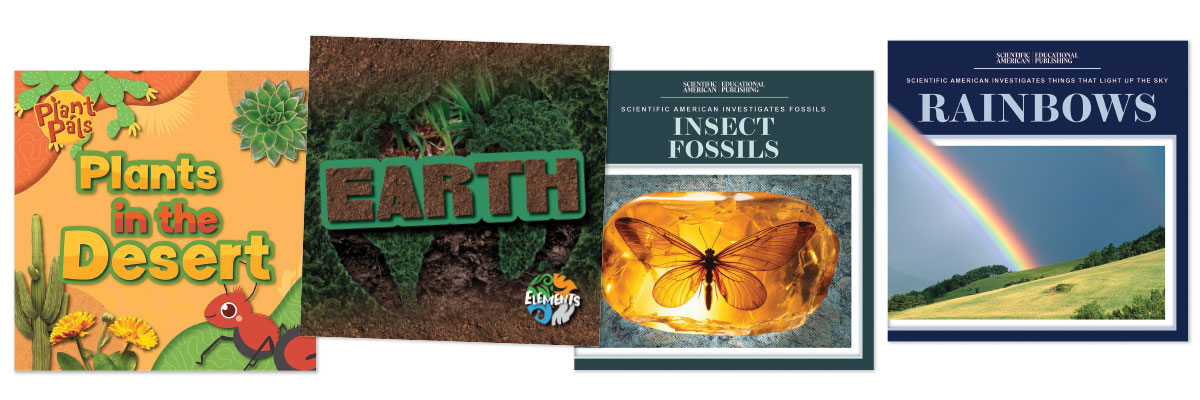A Wealth of Life | Natural Science Series Nonfiction
The colorful and welcoming titles in these series bring the fun to natural science topics.

This season is all about making science seem cool for everyone across interest levels. Learning about science in a broader context full of big ideas and a crisscrossing web of related connections is infusing joy into the pursuit of knowledge by making it relevant and interesting to younger readers. In addition to this, creators are bringing the fun back into science reading, incorporating and going beyond high-interest topics like the ever-popular dinosaurs and aliens. It is a great reminder that science is a large collection of overlapping fields where each of us can find a place of belonging and interest. Science is indeed for everyone.
Elementary
Andrews, E. C. Plants in the Desert. ISBN 9781534548787.
––––. Plants in the Marshlands. ISBN 9781534548817.
––––. Plants in the Ocean. ISBN 9781534548848.
––––. Plants in the Rainforest. ISBN 9781534548879.
ea vol: 24p. (Planet Pals). Greenhaven/KidHaven. Jan. 2025. Tr $26.23.
Gr 1-3–What do plants do and why are they important? This series covers plants that are key helpers in each ecosystem. Core ideas like photosynthesis are broken down and given visual explanations. A bug helper specific to the habitats covered in each title leads readers through the text. While the images are primarily photographs, the bugs and some cute illustrated faces add some whimsy that will appeal to young readers. One of the most valuable things these titles address is toxic plant life, which serves ecological purposes even if they are not for human interaction. VERDICT A playful, informative introduction that would fit well in school and classroom libraries.
Bischer, Karen. Fall. ISBN 9780756591106.
––––. Spring. ISBN 9780756591120.
––––. Summer. ISBN 9780756591113.
––––. Winter. ISBN 9780756590017.
ea vol: 24p. (Seasons of the Year). Capstone/Pebble. Jan. 2025. Tr $29.99.
K-Gr 2–How we experience the seasons is an topic that young readers can connect to since we all share this ever-changing planet. A somewhat meatier text for young readers that ties in familiar images of apple picking and snowball fights with some quality scientific explanations of how seasons occur in simpler terms. Details about seasonal animal sightings encourage readers to look outside their windows. Photographs show diverse children and families frolicking in the summer or bundled up in the winter as they make it through their cycle of seasons. VERDICT A nice update to the popular season books that incorporates the human element of experiencing seasons as well as the planetary aspects.
Greve, Meg. Digging Up Dinosaur Fossils in Africa. ISBN 9798892602372.
––––. Digging Up Dinosaur Fossils in Asia. ISBN 9798892602396.
––––. Digging Up Dinosaur Fossils in Australia. ISBN 9798892602402.
––––. Digging Up Dinosaur Fossils in Europe. ISBN 9798892602419.
––––. Digging Up Dinosaur Fossils in North America. ISBN 9798892602426.
––––. Digging Up Dinosaur Fossils in South America. ISBN 9798892602433.
ea vol: 24p. (Digging Up Dinosaur Fossils). Mitchell Lane/Little Mitchie. Jan. 2025. Tr $32.86.
Gr 1-3–Travel the globe to learn about new fossils from each continent. Going beyond the most common fossils that are well-known from Europe and North America, these titles transport readers from the dig sites of today back to the riversides and forests of prehistory to see the ancient creatures in their habitats. Through a mixture of photographs and colorful illustrations, each dinosaur is brought to vibrant reality across the pages. Simple sentences are paired with these images to explain core concepts and vocabulary related to the new specimens from all over the world. For dinosaur fans, these are an exciting collection of animals with familiar and potentially new species. VERDICT A great selection for school or public libraries as dinosaur books remain popular circulating materials.
Hall, Alex. Air. ISBN 9781482468526.
––––. Earth. ISBN 9781482468557.
––––. Fire. ISBN 9781482468588.
––––. Water. ISBN 9781482468618.
ea vol: 24p. (Elements). Gareth Stevens. Jan. 2025. Tr $24.27.
Gr 1-3–Bringing ancient Hellenistic concepts into the present day, the four essential elements are given a scientific update. Within a broader theme like air, readers are introduced to the connecting piece between extreme weather and simple breathing. The photographs do a nice job of conveying the spectrum of emotion connected to the elements, from the gentle crackling campfire to the terror of an uncontrollable wildfire. Natural history is woven into the text and images across these titles as a reminder that the ideas the elements inspire have been part of human curiosity about our world for millennia. VERDICT A visually interesting read that would be a welcome addition on public library shelves.
Howell, Izzi. Ancient Animals! The Biology of Prehistoric Life. ISBN 9780716673255.
––––. Anyone Out There? The Biology of Life in Space. ISBN 9780716673194.
––––. Evolved to Survive! The Biology of Adaptations. ISBN 9780716673163.
––––. Life and Death! The Biology of Life Cycles. ISBN 9780716673224.
––––. Look Inside! The Biology of the Human Body. ISBN 9780716673200.
Martin,Claudia. From Seed to Tree! The Biology of Plants. ISBN 9780716673187.
––––. Stay Strong! The Biology of Healthy Living. ISBN 9780716673217.
––––. Wildlife Working Together! The Biology of Ecosystems. ISBN 9780716673248.
Newland,Sonya. Climate Chaos! The Biology of Nature at Risk. ISBN 9780716673231.
––––. Feeling Sick? The Biology of Disease. ISBN 9780716673170.
ea vol: 48p. (Aha! Academy: Biology). World Book. Mar. 2025. Tr $22.
Gr 2-4–This series covers concepts students may wish they had learned in biology class. There are extraterrestrials, ancient mammals, and plant life all commingling around what it means to live and be alive. The fun is in seeing how these topics connect together through the wide-ranging subject of biology. Adding to this mix is discovering how humans fit into the conversation through discussions around nutrition and the climate. An effective combination of illustrated animals and scientific diagrams are used to hold the attention of readers while also giving them interesting information. VERDICT An enticing choice for school libraries that has a little something for everyone interested in biology.
Humphrey, Natalie. Dinosaur Fossils. ISBN 9781725351967.
––––. Human Fossils. ISBN 9781725351998.
––––. Insect Fossils. ISBN 9781725352025.
––––. Petrified Forests. ISBN 9781725352056.
––––. Plant Fossils. ISBN 9781725352087.
––––. Sea Creature Fossils. ISBN 9781725352117.
ea vol: 24p. (Scientific American Investigates Fossils). Rosen/Scientific American. Jan. 2025. Tr $26.27.
Gr 2-4–Continuing their legacy of bringing quality scientific information to eager readers, Scientific American is expanding what most people think of when they picture a fossil. The photographs bring to life the events of human prehistory and the Cambrian explosion while still maintaining the excitement around the geological aspects of fossils. Readers can feel like they too are in a petrified forest or at a dig as they learn about what paleontologists do in a visual way. For each image, there is an adjoining page of text to explain the context for what the readers are seeing and how fossils of all types come to be. VERDICT A substantial collection for avid readers of fossil and dinosaur books that would circulate well in public and school libraries.
Lombardo, Jennifer. Lightning. ISBN 9781725352179.
––––. The Northern Lights. ISBN 9781725352209.
––––. Rainbows. ISBN 9781725352230.
Reynolds,Donna. Comets. ISBN 9781725352148.
Washburne,Sophie. Shooting Stars. ISBN 9781725352261.
ea vol: 24p. (Scientific American Investigates Things That Light Up the Sky). Rosen/Scientific American. Jan. 2025. Tr $26.27.
Gr 1-3–Marveling at the sky above us remains a favorite pastime for aspiring scientists. By taking a close look at illuminations, readers can learn more about what lights up the sky during the day and at night. Topics like lightning, rainbows, stars, and the northern lights are highlighted, with fresh discussions about the science behind the phenomena. Excellent photographs are filled with sharp contrasts of the night sky and vibrant hues of the daytime. Keeping the pacing balanced with half text and half imagery, these books are perfect for young readers looking to learn more about observation-based science. VERDICT A wonderful choice for school and library collections as they cover a breadth of topics related to both light and the sky.

Martin, Claudia. Marine Ecosystems. ISBN 9798892328906.
––––. Marine Mammals & Seabirds. ISBN 9798892328913.
––––. Marine Plants & Invertebrates. ISBN 9798892328920.
––––. Marine Reptiles & Fish. ISBN 9798892328937.
ea vol: 48p. (Ocean Life). Bearport/Ursa. Jan. 2025. Tr $31.95.
Gr 3-5–This series is for readers who like to look into the wine-dark sea and wonder about its multitudes of life. Organized by life form, the ocean life covered in each volume comes together to form an ecosystem beyond fish. The inclusion of reptiles and birds, which might not be the first things readers picture when they think about the ocean, does a great job of subverting expectations. Well-chosen, vivid photographs of ocean life splash across the pages. The text is a little heavy and more technical, but there is still space to pause and marvel. VERDICT The tapestry of life explained across these titles would be perfect for school and public libraries.
Riley, Peter. The Body. ISBN 9781978541634.
––––. Habitats. ISBN 9781978541542.
––––. Plants. ISBN 9781978541573.
––––. Rocks and Soil. ISBN 9781978541603.
ea vol: 32p. (Step Into Science). Enslow. Jan. 2025. Tr $26.93.
Gr 2-4–This series features big-picture science that hooks readers and encourages them to go continue their learning journey, and captures the thrill of being introduced to science concepts. The illustrations are incredibly charming, with vibrant colors that catch the eye. Cute creatures follow readers across the pages to highlight facts or demonstrate ideas like growing carrots. There is a grandness to the world, a large size that allows the reader to step back and marvel at the things around them. Whetting the appetite for science, they make an accessible collection for classroom and school libraries. VERDICT These titles are a great choice for young readers who are excited about science and want to learn more independently inside and outside of the classroom.
Upper Elementary to Middle School
Rice, Eleanor Spicer. The Deadliest: Big Cat. Feb. 2025. ISBN 9781324053736.
––––. The Deadliest: Flower. Jul. 2025. ISBN 9781324053774.
––––. The Deadliest: Snake. Jul. 2025. ISBN 9781324053750.
––––. The Deadliest: Spider. Feb. 2025. ISBN 9781324053712.
ea vol: illus. by Max Temescu. 40p. (The Deadliest). Norton. Tr $17.99.
Gr 3-7–Keeping things light and humorous, these science comics are packed with killer facts. Informative while remaining irreverent and quite funny, these titles present readers with a cadre of dangerous living things from the world around them. More than just the apex predators familiar to many readers from food webs, there are also deadly plants and creepy crawlies like spiders. The art is done in a comic book style that blends some anthropomorphism for comedic and dramatic effects with more lifelike imagery. The jokes and facts in the text pair flawlessly with Temescu’s art, which is full of visual gags. VERDICT These books would circulate well in public libraries as fun entrées to the science comics area that has been growing over the last few years.
Upper Middle School to High School
McClure, Leigh. Animal Adaptations. ISBN 9781502673275.
––––. Cells. ISBN 9781502673367.
––––. Genetics. ISBN 9781502673336.
––––. The Human Body. ISBN 9781502673305.
––––. Life Cycles. ISBN 9781502673244.
––––. Plant Parts and Photosynthesis. ISBN 9781502673213.
ea vol: 32p. (The Inside Guide: Biology Basics). Cavendish Square. Jan. 2025. Tr $30.21.
Gr 8 Up–Biology is a varied collection of areas of finer study that this sampling of related subjects puts on full display. Step into the worlds of cytology or botany with the eyes of a scientist as each field is broken down into its components. Scientific diagrams and photographs are used throughout to show the diverse facets of the life sciences. Well-known examples such as the pea experiments are discussed in connection to the bigger ideas and the wider concepts of biology. Fast facts give handy information and a small break in the text for readers to pause between some of the denser passages. VERDICT Welcome on high school library shelves as a nice support to their biology curriculum.
Two standout series seamlessly blend teaching and entertainment. The artwork for “Step Into Science” (Enslow) will have readers coming back to look at what is happening on each page. In a similar vein, the funny art and writing of “Deadliest” (Norton) was made for readers to pass among their friends. It is the peak of accessible, fun science that educates while maintaining sufficient levity to keep readers engaged with the content. Both sensational in their own way and each welcomes readers back again and again with their appealing visual styles.

FALL 2025 SERIES MADE SIMPLE REVIEWS
RELATED
The job outlook in 2030: Librarians will be in demand
The job outlook in 2030: Librarians will be in demand
ALREADY A SUBSCRIBER? LOG IN
We are currently offering this content for free. Sign up now to activate your personal profile, where you can save articles for future viewing






Add Comment :-
Be the first reader to comment.
Comment Policy:
Comment should not be empty !!!